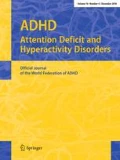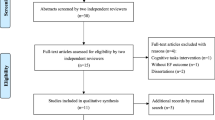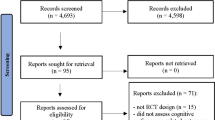Abstract
Difficulties in sustaining posture can present with features associated with hyperactive behaviour listed in DSM-5 and ICD-10 classifications for ADHD. Information from a system measuring motor activity during a neurocognitive test (QbTest), occupational therapist reports and Conners rating scales are compared between cases with and without posture problems. Weakness in sustaining posture results in elevated activity measures during infrared motion analysis. Strong posture on the other hand appears to mitigate activity levels. Posture is an independent factor which requires consideration during the assessment of ADHD.







Similar content being viewed by others
References
Arnsten AFT, Steere JC, Hunt RD (1996) The contribution of alpha 2 noradrenergic mechanisms to prefrontal cortical cognitive functions: potential significance to attention-deficit hyperactivity disorder. Arch Gen Psychiat 53:448–455
Barkley RA (1991) The ecological validity of laboratory and analogue assessment methods of ADHD symptoms. J Abnorm Child Psychol 19:149–178
Barkley RA (1997) Behavioural inhibition, sustained attention, and executive functions: constructing a unifying theory of ADHD. Psychol Bull 121:65–94
Castellanos FX, Proal E (2012) Large-scale brain systems in ADHD: beyond the prefrontal-striatal model. Trends Cogn Sci 16(1):17–26
Conners CK (2008) Conners 3rd edn. manual. Multi-Health Systems Incorporation, Toronto, ON
Dickstein SG, Bannon K, Castellanos FX, Milham MP (2006) The neural correlates of attention deficit hyperactivity disorder: an ALE metaanalysis. J Child Psychol Psychiatry 47:1051–1062
DuPaul GJ (1991) Parent and teacher ratings of ADHD symptoms: psychometric properties in a community-based sample. J Clin Child Adolesc Psychol 20:245–253. doi:10.1207/s15374424jccp2003_3
Edwards M, Gardner E, Chelonis J, Schulz E, Flake R, Diaz P (2007) Estimates of the validity and utility of the Conners’ continuous performance test in the assessment of inattentive and/or hyperactive-impulsive behaviors in children. J Abnorm Child Psychol 35:393–404
Hall CL, Valentine AZ, Groom MJ, Walker GM, Sayal K, Daley D, Hollis C (2016) The clinical utility of the continuous performance test and objective measures of activity for diagnosing and monitoring ADHD in children: a systematic review. Eur Child Adolesc Psychiatry 25(7):677–699
Himmelstein J, Schulz KP, Newcorn JH, Halperin JM (2000) The neurobiology of attention-deficit hyperactivity disorder. Front Biosci 5:461–478
Mefford IN, Potter WZ (1989) A neuroanatomical and biochemical basis for attention deficit disorder with hyperactivity in children: a defect in tonic adrenaline mediated inhibition of locus coeruleus stimulation. Med Hypotheses 29:33–42
Miller LJ, Nielsen DM, Schoen SA (2012) Attention deficit-hyperactivity disorder and sensory modulation disorder: a comparison of behaviour and physiology. Res Dev Disabil 33(3):804–818
Nakagawa H, Ohashi N, Watanabe Y, Mizukoshi K (1993) The contribution of proprioception to posture control in normal subjects. Acta Otolaryngol Supplementum 504:112–116
Nigg JT (2006) What causes ADHD? Understanding what goes wrong and why. The Guildford Press, New York. ISBN-10 1-59385-267-3, ISBN-13 978-1-59385-267-2
Nigg JT, Stavro G, Ettenhofer M, Hambrick DZ, Miller T, Henderson JM (2005) Executive functions and ADHD in adults: evidence for selective effects on ADHD symptom domains. J Abnorm Psychol 114(4):706–717
Osterlan J, Logan GD, Sergeant JA (1998) Response inhibition in AD/HD, CD, comorbid AD/HD + CD, anxious, and control children: a meta-analysis of studies with the stop task. J Child Psychol Psychiatry 39:411–425
Reh V, Schmidt M, Lam L, Schimmelmann BG, Hebebrand J, Rief W, Christiansen H (2013) Behavioral assessment of core ADHD symptoms using the QbTest. J Atten Disord 19(12):1034–1045
Rubia K (2011) “Cool” inferior frontostriatal dysfunction in attention-deficit/hyperactivity disorder versus “hot” ventromedial orbitofrontal-limbic dysfunction in conduct disorder: a review. Biol Psychiatry 69:69–87
Schlee G, Neubert T, Worenz A, Milani TL (2012) Children with ADHD show no deficits in plantar foot sensitivity and static balance compared to healthy controls. Res Dev Disabil 33(6):1957–1963
Shorer Z, Becker B, Jacobi-Polishook T, Oddson L, Melzer I (2012) Postural control among children with and without attention deficit hyperactivity disorder in single and dual conditions. Eur J Pediatr 171(7):1087–1094
Sonuga-Barke EJ (2002) Psychological heterogeneity in AD/HD–a dual pathway model of behaviour and cognition. Brain Res 10 130(1–2):29–36
Teicher MH, Ito Y, Glod CA, Barber NI (1996) Objective measurement of hyperactivity and attentional problems in ADHD. J Am Acad Child Adolesc Psychiatry 35:334–342
Teicher MH, Lowen SB, Polcari A, Foley M, McGreenery CE (2004) Novel strategy for the analysis of CPT data provides new insight into the effects of methylphenidate on attentional states in children with ADHD. J Child Adolesc Psychopharmacol 14(2):219–232
Ulberstad F (2012) QbTest technical manual, rev edn. Qbtech AB, Stockholm
Willcutt EG, Doyle AE, Nigg JT, Faraone SV, Pennington BF (2005) Validity of the executive function theory of attention-deficit/hyperactivity disorder: a meta-analytic review. Biol Psychiatry 57:1336–1346
Acknowledgements
The author would like to thank Fredrik Ulberstad, Research Director, QbTech, for editing the QbTest reports and QbTech for the permission to publish the QbTest reports in this paper.
Author information
Authors and Affiliations
Corresponding author
Ethics declarations
Conflict of interest
The author declares no conflict of interest.
Informed consent
Informed consent was obtained from all individual participants included in the study.
Rights and permissions
About this article
Cite this article
Vogt, C. The risk of misdiagnosing posture weakness as hyperactivity in ADHD: a case study. ADHD Atten Def Hyp Disord 9, 239–251 (2017). https://doi.org/10.1007/s12402-017-0221-1
Received:
Accepted:
Published:
Issue Date:
DOI: https://doi.org/10.1007/s12402-017-0221-1




